Vacuum cleaners: types, principle of operation and operating instructions
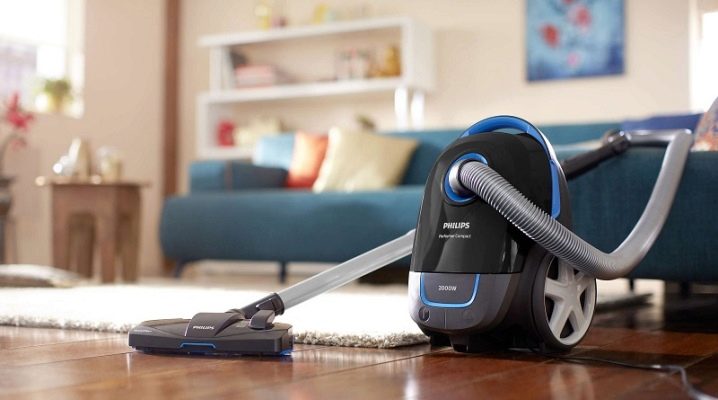
The vacuum cleaner has been invented twice as a device for cleaning carpets and household clothes from dust. The first "father" of the vacuum cleaner was Daniel Hess from the USA, having received patent No. 29077 for the "Carpet Sweeper" device in 1860. Rotating brushes removed dust from the surface of the carpet and outerwear, then a system of bellows with valves sucked in air together with dust and passed it through 2 chambers with water. The dust remained floating on the surface of the water, and the purified air was thrown into the room. The second "father" of the vacuum cleaner was the English civil engineer Hubert Cecil Booth. In 1901, he invented a mechanical device for cleaning carpets and other household items from small debris and dust. Shrouded in puffs of puffing smoke, Puffing Billy (literally translated "puffing Bill") was powered by a single-stroke gasoline engine.

Peculiarities
A bulky, noisy, puffy, pungent device was placed in a large wooden barrel with a small amount of water at the bottom to humidify the air filter. A fan impeller on the same shaft with a gasoline engine sucked in air with dust inside the device and passed it through a thick felt washer, to which a centrifugal pump continuously supplied water. Dust, soot and soot particles settled on the wet felt. The heavy cart was carried by a harnessed pair of horses.
At the end of 1901, Hubert Booth, having received the royal seal of approval (an analogue of a modern patent for an invention) and a large monetary award, replaced the gasoline engine with an electric one and installed a wire rheostat to smoothly adjust the fan speed. These design changes significantly reduced noise and eliminated smoky exhaust.

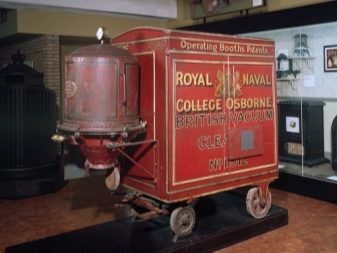
Booth's electrically powered vacuum cleaner was used to remove dust from carpets and rugs by a servant of the royal court of Westminster Abbey during the coronation and reign of King Edward VII. So, according to the testimony of historians, a modern universal device for cleaning garbage and dust appeared.
Since its invention, the weight, size, shape of the body and the function of the vacuum cleaner have changed a lot. Today, the garbage collection unit is a powerful, compact, high-tech, learnable device with a microcontroller. The pinnacle of engineering development in this direction is undoubtedly a robot vacuum cleaner. This modern high-tech unit with a built-in air turbine, a powerful computer, two night vision cameras for obtaining a stereoscopic image of objects, a variety of body and temperature sensors, built-in brushes and a bell for garbage collection, after a full charge of the batteries, maintains autonomy for 4 hours.


After 3.5 hours, it automatically enters the power supply search mode. Seeing an electrical outlet 220V or a computer with a USB connector on the floor plan or with the help of its built-in web cameras, the unit recharges its batteries completely independently. An infrared camera and an ultrasonic locator allow him to move freely around the room in absolute darkness. After entering the digitized floor plan into the RAM, the robot can perform wet and dry cleaning in the room, bypass obstacles (tables, cabinets, chairs).
After an arbitrary rearrangement of things and furniture in the room, in order to adapt to the new conditions, the cleaning robot needs to scan the room three times with its cameras, bypassing it along the perimeter and diagonals. The basic software that the developers armed with the robot vacuum cleaner was used to control the robotic arms on the roof of the emergency power unit. The program has tremendous opportunities in terms of self-study and adaptation to changing environmental conditions.

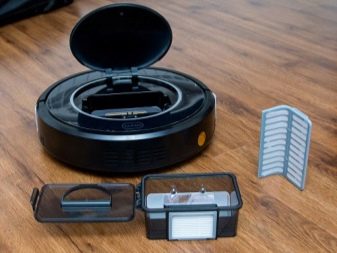
Device
Regardless of the brand and manufacturer, household vacuum cleaners consist of the following main units:
- garbage collection device: brushes, bells, rollers, slotted, sprayers;
- body: electric motor, turbine, dust collector, filters;
- devices for transporting the collected waste to the dust collector: pipes, hoses, built-in channels.
The garbage collection device is the main functional unit in the design of the vacuum cleaner. A number of mutually exclusive requirements are imposed on this node:
- large socket area - ensuring sufficient vacuum to suck in debris along with air;
- light weight and dimensions for easy penetration into hard-to-reach places - reliable contact with the treated surface;
- narrow specialization of nozzles - a wide variety of physical properties of the surfaces to be cleaned from dust.


The body is the main protective element of the vacuum cleaner. Made of plastic, metal or plastic. The housing protects:
- a person from electric shock in case of accidental contact with live parts;
- internal parts of the vacuum cleaner from splashing water and dust.


Principle of operation
The vacuum cleaner works according to Bernoulli's law, known to everyone from school. An air turbine creates a vacuum inside the cleaner body. The vacuum is distributed through the suction pipe to the brush or bell. The low pressure zone under the brush or flare sucks in air at high speed along with dust and debris. Further through the pipe, the air flow enters the waste collection compartment, where dust particles and small waste settle on the filter. Dust-free air is thrown back into the room through a hole in the back of the case.
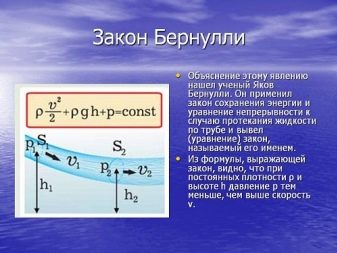

According to Bernoulli's law, the law of a "natural vacuum cleaner" - a tornado - works. The air, moving at high speed in a spiral above the earth's surface, creates a pressure drop that uproots centuries-old trees, breaks power lines, destroys suspension bridges, lifts water from rivers and lakes into the air, overturns cars, and rips roofs off houses. Cyclone vacuum cleaners work on the principle of tornadoes.
The high speed air turbine creates a swirling air movement inside the cleaner body. The low pressure zone extends along the connecting pipe to the brush socket. Debris and dust particles from the surface of the carpet or floor are sucked in together with the air flow through the brush socket and connecting pipe and into the dust collection compartment. The dusty air inside the compartment under the action of a high-speed air turbine is twisted into a tight spiral. The centrifugal force "squeezes" mechanical dust particles onto the polished side wall of the dust collection compartment. Due to its own weight, debris and dust particles are collected in a funnel at the bottom of the compartment.

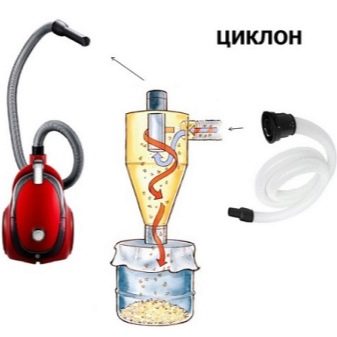
Types and their characteristics
Specialists and developers use the International Classification of Goods and Services (ICGS) or ISO standards to classify vacuum cleaners. To simplify the procedure, sellers and marketers classify household electrical waste collection devices as follows:
- vacuum cleaners for dry cleaning (with disposable paper dust bags, with reusable fabric dust bags, with a water filter for dust);
- washing vacuum cleaners;
- robotic vacuum cleaners;
- vacuum cleaner in the form of a mop with a steam cleaner;
- separator vacuum cleaners.

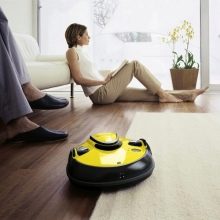

By the design of the dust collector
Vacuum cleaners are:
- with a cloth or paper bag;
- container (cyclonic);
- container with a humidifier (aquafilter).
A cloth or paper dust collector works like a conventional air filter. Micron pores in paper or fabric trap large particles of dust, chalk, soot and other dry substances. The bag full sensor switches off the turbine when the filter is full. Pros of a paper or cloth filter:
- low price;
- cleaning is done by usual shaking.
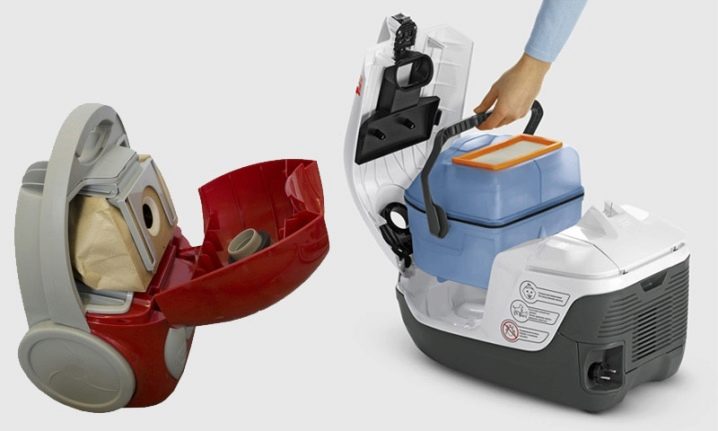
Cons of a paper or cloth filter:
- subject to mechanical wear;
- when working with fine building materials (cement, gypsum), the filter cannot be completely cleaned;
- when working intensively or with a lot of dust, frequent replacement is required.


The container (cyclone) dust collector is a non-separable plastic cartridge with a dry filter element. Used in Cyclone vacuum cleaners. The positive quality of the container dust collector is quick and easy cleaning by simply shaking it over the bin. The negative quality of the container dust collector is that the plastic container is highly electrified during operation; when touched for removal and further cleaning, a rather sensitive discharge of static electricity usually occurs on the fingers.
The container dust collector with an aquafilter (humidifier) is a cartridge filled with water. The air at the filter inlet is split into tiny micron-sized bubbles. Air purification from debris takes place in a fluidized bed. The area of contact of the liquid with air containing debris in the fluidized bed increases by 4-6 times.
To improve the wetting of small particles of debris, followed by settling to the bottom of the cartridge, a surfactant is added to the liquid filling the cartridge.


When air with particles of debris, smoke or dust is pumped through such a liquid, small particles are wetted with water, followed by sticking and settling to the bottom of the aquafilter. The transparent walls of the cartridge make it possible to visually control the degree of filling the compartment with dust during the cleaning process. Aquafilter pluses:
- high degree of air purification from debris, smoke and dust;
- cleaning contaminated aquafilter from contamination.
Disadvantages of aquafilter:
- increased resistance to air flow;
- the cleaning process takes a long time.

By specialization
There are the following types of vacuum cleaners.
- Outdoor. The most common type of vacuum cleaner for dry and wet cleaning of premises. The body with the garbage collection device is connected to the floor dust collector with a corrugated or telescopic pipe. The vacuum cleaner moves across the floor on two, three or four wheels.
- Manual. They are used for cleaning dust in the passenger compartment, in a wardrobe with outerwear and in small areas.
- Vertical or vacuum mops. The casing, dust collector and motor with fan are integrated into the casing near the suction pipe.
- Built-in. The power plant and dust collector are installed in technological niches or between the partitions of the house. The size of the working area is limited by the length of the hoses. A significant drawback: to repair the built-in vacuum cleaner, it is necessary to dismantle part of the room.
- Automotive. Powered by 12V vehicle on-board network. They differ from others in their small size and high power.
Through a rectifier, you can connect to a 220V network.



By layout
The power, functionality and design of the case depend on the presence of individual units (layout) in the vacuum cleaner. A modern household vacuum cleaner consists of separate unified units for:
- ensuring high-quality assembly by robotic manipulators without human intervention;
- interchangeability with other models of individual parts and assemblies;
- use for the work of a universal set of nozzles;
- use of unified plastic cases of modern design.
Over the past 50 years, developers obsessed with increasing sales at all costs have created many varieties of vacuum cleaners and other devices for cleaning homes and cleaning household items from dust. To put things in order in the developments, the inventors have created a detailed classifier based on the consumer properties of a particular model. In accordance with this classifier, all the variety of models of commercially available vacuum cleaners can be subdivided into the following types.



- Floor. The most common type of household vacuum cleaner for cleaning apartments and offices. The body in the process of cleaning moves along the floor on two or four rollers. The large capacity dust collector allows cleaning several rooms without cleaning the dust filter with partial disassembly of the case. A set of interchangeable brushes, bells and sprays allows you to perform wet and dry cleaning, dust removal, painting walls and ceilings, and other work.
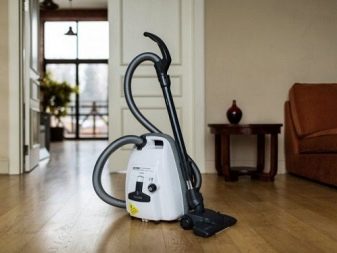

- Vertical. It is used for cleaning the apartment. It differs from other models by its narrow, vertically located body and the absence of a hose. The narrow vertical body of the vacuum cleaner can penetrate into the narrowest and other hard-to-reach places. In the process of work, there is no need to bend over or press hard on the brush.
This feature makes this type of vacuum cleaner irreplaceable helpers for people with disabilities, fractures and other diseases of the musculoskeletal system.
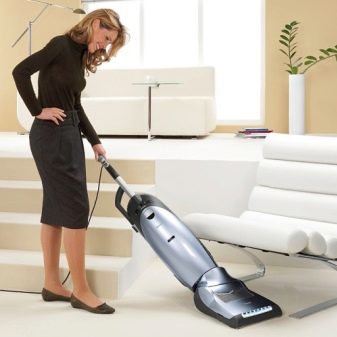
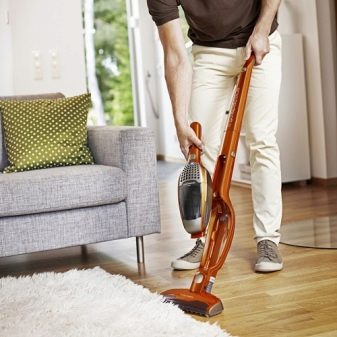
- Built in. It is used for cleaning luxury apartments. The architects of such apartments pay great attention to built-in appliances. This approach to planning allows you to increase the "living space", remove all corners protruding into the room, remove the stove, refrigerator, air conditioner, wardrobe and cupboard in the wall niches. It is especially convenient to use the built-in vacuum cleaner when arranging living rooms or bedrooms on two levels.
During the cleaning process, you do not need to move the vacuum cleaner to the second floor along a spiral staircase.


- Cyclonic. Refers to vacuum cleaners without a trash bag. Air and dust particles coming from the suction line are spiraled in the waste collection container, rotating at a speed of 8,000 to 10,000 rpm. Centrifugal force throws dust and debris particles onto the inner wall of the housing. Particles of dust and debris under their own weight slide down the polished surface and fall into the water tank.
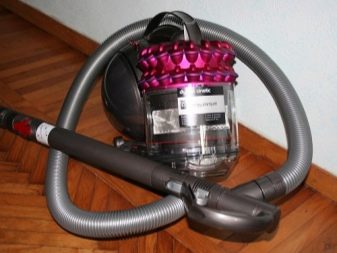

- Washing. The unit contains two containers and is designed for wet cleaning of laminated floors, carpet tracks or varnished parquet. The fresh water tank is filled with water from the tap with the addition of a cap of liquid soap or a pasty detergent. The waste water tank remains empty. At the beginning of cleaning, water with detergent is sprayed on the floor through a special nozzle. 10-15 minutes after replacing the nozzle, the vacuum cleaner switches to suction mode to remove dissolved dirt and excess liquid from the floor.


Attention! The vacuum cleaner should be used with caution when wet cleaning unlacquered parquet or unpainted wooden floorboards. To prevent the parquet from rising "on its hind legs" and cracking of the floorboards from swelling of the tree from excess moisture, it is necessary to remove the liquid with a vacuum cleaner a few minutes after the end of spraying.
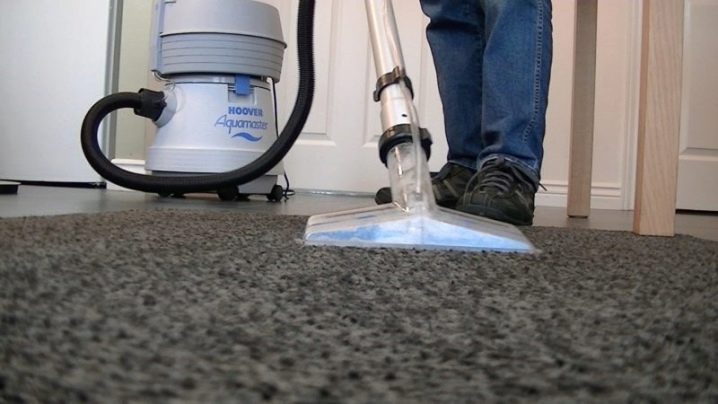
- Robot vacuum cleaner. A thick round disc in the shape of a tablet with protruding touch probes, many sensors and flashing indicators - this is how a robot vacuum cleaner looks like, which works under the control of microcontrollers. The smart device is powered by built-in lithium polymer batteries. One charge lasts for 3 hours of continuous use. Before starting cleaning, you need to enter a detailed digitized floor plan into the device's RAM, pour water and detergent into the container. After that, it remains to press the "start" button and wait for the end of the process.


- Sofa. In order for the upholstered furniture to be a place for rest and not to spread textile mites around the apartment, fine dust and debris have been developed and serially produced vacuum cleaners for upholstered furniture. Sofa vacuum cleaners are equipped with a turbo brush and an ultraviolet lamp.
The fine dust filter makes the cleaning process as comfortable as possible.


- Vertical cordless vacuum cleaner "2 in 1".
The device has a number of unique features:
- complete independence from an electrical outlet;
- fast battery charging within 3-4 hours;
- transparent waste bin with visual control of the filling level;
- quick cleaning of the container without contact with dust;
- a powerful turbine with a suction line shut-off sensor;
- pressure regulator on the suction pipeline;
- a voltage stabilizer allows maintaining a constant suction power when operating from a battery;
- the ability to separate the suction block from the handle.

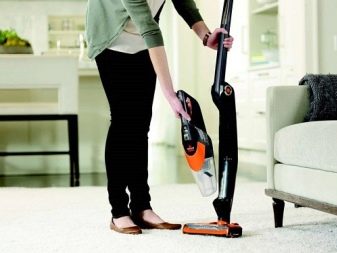
- Separator. The powerful centrifuge sucks up debris along with dust and dirt, after which it enters the water tank. The centrifuge spins the water at up to 30,000 rpm. Centrifugal force pushes dust and debris against the polished tank walls and settles them to the bottom.


- Cyclonic type. In a cyclone vacuum cleaner, a powerful vortex air flow with dust enters the cleaning tank. Plastic ribs inside the chamber squeeze a miniature tornado, debris and dust fall to the bottom. The air purified from dust is thrown out of the vacuum cleaner into the room. In the design of the cyclone-type vacuum cleaner there are no usual filters for dust from padding polyester.
The main disadvantage of these vacuum cleaners is the high-frequency sound, reminiscent of the noise from a jet airliner taking off.


- Stationary (built-in). It is used for dry and wet cleaning of large apartments, offices, shops and supermarkets. It is a wet and dry cleaning system built into the building.
A stationary vacuum cleaner consists of the following main units:
- central unit;
- pneumatic valves;
- air ducts;
- hose with telescopic handle;
- replaceable nozzles.
The main disadvantage of a built-in vacuum cleaner is the complexity of cleaning filters from dust, maintenance and repair. For the repair and maintenance of a stationary vacuum cleaner, partial dismantling of the building structure is required: removal of false panels and partitions, temporary disconnection of electrical cables or partial dismantling of hidden wiring.
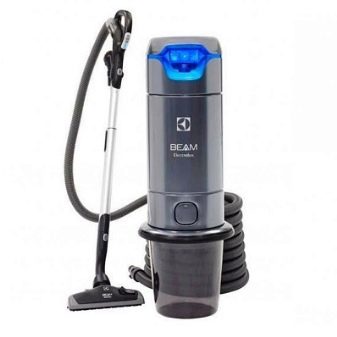

- Extractor. Specialized vacuum cleaner for dry cleaning and washing carpets and floor coverings at home. The moisture-proof design of the turbine and the special design of the pipelines exclude the ingress of moisture on the current-carrying elements of the structure.
The vacuum cleaner-extractor consists of:
- a removable plastic tank resistant to shock and chemicals;
- a two-stage suction turbine;
- a centrifugal pump for supplying a double diaphragm detergent in a moisture-proof capsule;
- removable detergent tank with antifoam device;
- fast-acting short-circuit and overload protection.
To facilitate movement on carpet in the body of the vacuum cleaner there are spherical stops with polycarbonate balls instead of wheels.


By appointment
By their intended purpose, household and household vacuum cleaners are subdivided into:
- general purpose devices;
- specialized devices;
- dry cleaning devices;
- devices for wet cleaning.
With the help of a vacuum cleaner, you can perform dry cleaning of the premises and wet cleaning. For each type of cleaning, manufacturers produce general-purpose and special devices. According to the operating mode of the device for cleaning dust, there can be:
- floor-standing (weighing 3-8 kg);
- manual (weighing up to 3 kg).


Manual are of the following types:
- rod, have a rod or handle on the body;
- knapsack, fastened in the form of a knapsack behind the back or in the form of a bag over the shoulder.
By design, vacuum cleaners are:
- horizontal straight-through;
- vertical with cyclone;
- with a dust collector in a fluidized bed.


By comfort:
- standard design;
- superior comfort.
To increase comfort, manufacturers usually use:
- transparent indicator to control the degree of filling of the dust compartment;
- emergency switch in case of overflow of the dust compartment;
- thyristor-based regulator for smooth change of the turbine rotation speed;
- spring power cord stacker;
- replaceable cassette for paper filters;
- a device for pressing dust into bags;
- plastic case for storing additional accessories;
- remote control unit.


According to the storage method, vacuum cleaners are divided into:
- stored openly (when inoperative, packed in a box or pouf);
- built-in (do not require packaging for storage).
In addition to the above features, devices are classified by power, brands, models, countries, manufacturers.


Accessories
Using separately purchased components, you can independently assemble accessories for the vacuum cleaner (paint sprayer, separator). This approach will help to save as much as possible on the conversion of the vacuum cleaner without compromising quality. The adapter (adapter) allows you to use attachments from a vacuum cleaner model of another manufacturer for operation. This approach maximizes the scope of the device while significantly saving money. Those who own a lathe can make a universal adapter for a vacuum cleaner with their own hands according to drawings from the Internet. A corrugated hose (corrugated) is usually used to connect the body to the brush.
Corrugation with a diameter of 32 mm is suitable for vacuum cleaners LG, Samsung, Elenberg, Thomas, Bosch, Philips.


The aspirator is used to suck fluid from the respiratory system using a vacuum cleaner. The aspirator works according to Bernoulli's law due to the pressure difference. Forced removal of mucus and fluid is necessary for bronchial asthma, pneumonia, congestion in the upper respiratory tract. The design of the aspirator makes it completely safe to use. With the help of adapters, the vacuum cleaner turns into a universal device for cleaning floors, carpets and furniture from dust, painting a car, treating a garden from pests, ventilating a cellar and a polycarbonate greenhouse, preparing barbecue and stewed potato dishes on the grill.
For apartments where patients with tuberculosis, HIV, venereal and other chronic and dangerous diseases live, it is recommended to pay attention to a wet cleaning brush with a built-in UV emitter. When the emitter is turned on and a 2% chloramine solution is used for wet cleaning, the vacuum cleaner provides complete sterilization of the room for 3 hours.
Such a brush will also be useful for disinfecting an apartment after influenza or ARVI.

Selection Tips
A modern vacuum cleaner is a complex electronic device based on microprocessors. Before buying it, you should carefully read the detailed description of the selected model on the manufacturer's website and make a selection according to the parameters. It is better not to use the description on the websites of sellers of complex household appliances, it has a pronounced "PR-connotation", perhaps the absence or distortion of technical parameters, there is no description of the shortcomings.
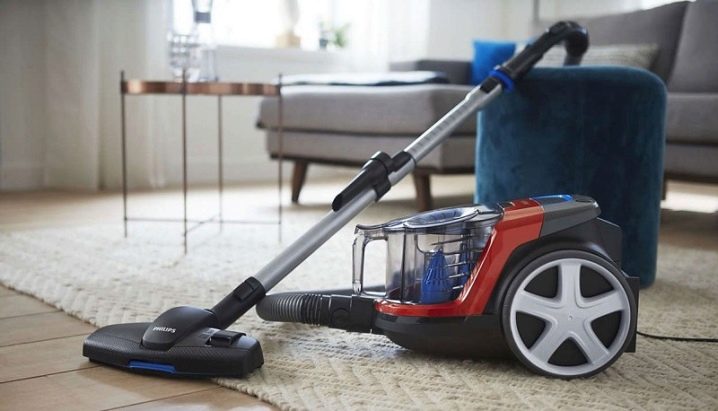
In the absence of a description in Russian on the manufacturer's website, you can use an online translator for free, which is available on major Internet portals. In the technical description of household appliances, there are no complex adverbial phrases, so machine translation will be quite enough for understanding and careful study. When purchasing a modern vacuum cleaner for the home, you need to choose it according to a number of important parameters:
- turbine location (vertical, horizontal, filter cyclone);
- air turbine power;
- air purification system;
- weight and dimensions;
- type of filter element (filter paper bags, cyclone filter, aquafilter);
- the ability to carry out wet cleaning of the floor and carpet using the unit;
- user reviews on forums on the Internet, discussion of the advantages and disadvantages of the model.

For travelers and employees who often travel on business trips, it is recommended to purchase a travel or car vacuum cleaner that is small in size and weight.
Using a set of Euro plugs and adapters, you can connect the vacuum cleaner to a power outlet in any country in the world.

User manual
When using a vacuum cleaner, you must follow the rules of electrical safety and fire safety. Strict adherence to them will ensure reliable operation of the device and increase its service life.
- The vacuum cleaner must be operated in a dry, ventilated area at room temperature.
- Before turning on the vacuum cleaner, it is necessary to visually check the absence of fluid leakage from the inside of the case, the serviceability of the electrical outlet and the plug, the integrity of the connecting cord.
- After being transported from the store at a negative temperature or after long-term storage in an unheated loggia or on a balcony in winter, it is necessary to keep the vacuum cleaner in the room before turning it on for at least 6-8 hours to dry out condensation drops on the case and conductive parts and parts.
- It is forbidden to use the vacuum cleaner at the time of power surges, frequent power outages.
- It is forbidden to use non-standard power cords and fuses, add aromatic oils, toilet water, herbal teas, deodorants, aggressive chemical liquids to the water of the humidifier compartment.
- Do not turn on the vacuum cleaner in the presence of paper dust, wood chips, fine silicate or abrasive dust, explosive, aggressive and highly active gases and liquids (gasoline, solvents, acetone, dichloroethane, high oxygen content) in the air.
- It is strictly forbidden to turn on the vacuum cleaner after a strong impact on the body or falling from a great height.
- If a crackling, burning smell, smoke appears during operation, it is necessary to urgently turn off the vacuum cleaner and contact a service workshop.
- It is strictly forbidden to remedy the malfunction yourself.
Failure to do so may result in electric shock or device damage.

You can find out the principle of operation of the Krausen separator vacuum cleaner by watching the video below.













The comment was sent successfully.